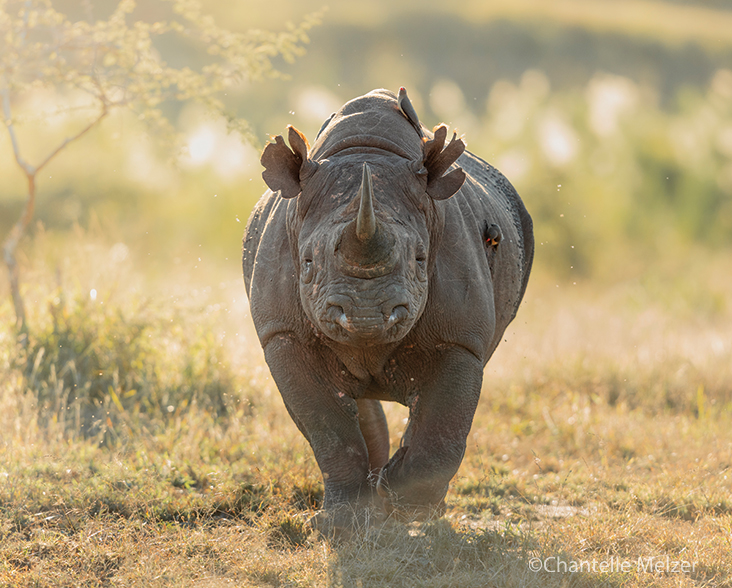Species Data
Class: Mammalia
Order: Perissodactyla
Family: Rhinocerotidae
Scientific Name: Diceros bicornis
IUCN Red List status: Critically Endangered
Description
Contrary to their English names, the skin colour of both Black and White Rhinos is dark brown to grey. They are best told apart by the shape of their lips, with the Black Rhino having a pointed, hooked rather than a square upper lip. Black Rhinos are also smaller, have a less pronounced hump on the back of the neck and a smaller head. Black Rhinos have two horns that grow continually from their base throughout their life at a rate of up to three inches a year. The anterior horn is longer than the posterior horn, averaging about 50 cm, but is known to reach an incredible five feet long. Males tend to have thicker horns, whereas females have longer, thinner horns. Black Rhinos reach 1.6 metres tall at the shoulder, with females weighing up to 900 kg and bulls up to 1,350 kg. They live up to 35 years in the wild and females reach sexual maturity at 3.5-4 years old.
The Black Rhino has four subspecies: the nominate (South Western) Black Rhino Diceros bicornis bicornis, the Southern Central Black Rhino D. b. minor, Eastern Black Rhino D. b. michaeli, and the recently declared extinct Western Black Rhino D. b. longipes.
Behaviour
Black Rhinos are herbivorous, mostly foraging at night, dawn and dusk, using their pointed prehensile upper lip to browse on leaves, fruit, seeds, twigs and even bark, using their horns to break or knock down trees and bushes to access higher branches. During the day, they shelter from the sun in the shade and often keep cool by rolling in mud.
Adult female Black Rhinos are generally accompanied by a calf, but otherwise, adults of both sexes are mostly solitary and territorial during the day. However, while visiting water holes at night, they are much more sociable, congregating in small groups, engaging in courtship and even mating.
Adult males and females are territorial, with older males usually dominant over younger individuals. Population density varies greatly depending on region and food availability, with territory sizes ranging from just 2.6 km2 up to 133 km2, increasing where food is harder to find. Black Rhinos have poor eyesight, but good hearing and an even better sense of smell, and they communicate by rubbing a scent gland on their head against trees and rocks, and leaving dung piles known as middens and spraying urine to mark territories.
Breeding occurs throughout the year. During courtship, males follow females, including those with a dependent calf, for one or two weeks before mating. Females give birth alone after a gestation period of 15-17 months. Calves weigh 30-45 kg at birth and can stand within a few hours. After two months calves are weaned but stay with their mother for 2-4 years.


Habitat
Black Rhinos inhabit a diverse range of habitats, including deserts, savanna, shrubland, montane forests, wet forests, and wetlands, typically within a 5-10 mile radius of mineral licks and a water source.
This species occurs across eastern and southern Africa, with 94% found in South Africa (which supports the majority), Namibia, Kenya and Mozambique, and the rest in Angola, Tanzania, and Zimbabwe. The Black Rhino has been reintroduced to Botswana, Chad, Malawi, Eswatini, Rwanda, and Zambia.
Threats and Conservation
The main threat to the Black Rhino remains poaching for the illegal international trade in rhino horn. The Black Rhino population in Africa fell to around 100,000 by 1960 due to hunting and habitat loss for settlement and agriculture. Numbers then plummeted by 98% to around 2,500 in 1992, and although formerly occurring across much of sub-Saharan Africa, this species is now extinct across the northern half of its historical range. Poaching peaked in 2015, and numbers are today increasing, but recovery of the population is hindered by continued poaching, and the Black Rhino remains categorised as Critically Endangered on the IUCN Red List.
South Africa is the main source of illegally traded horns, with most ending up in south-east Asia, especially Vietnam and China. In Vietnam, rhino horn is in high demand by wealthy urban upper-middle-class citizens, who strongly believe in the purported health benefits and consider its use a symbol of power, success and high social status. As well as its use in traditional medicine to treat anything from fever and nosebleeds to preventing strokes and curing cancer, rhino horn is also carved into ornaments such as bowls and bangles that are frequently bought by and gifted to family members, friends, business colleagues, celebrities, and government officials. Demand for rhino horn is expected to increase as more people attain the economic means to become consumers.
International commercial trade in Black Rhino and its products has been banned under CITES Appendix I since 1977. However, domestic legislation prohibiting trade is poorly enforced in key consumer countries. Protection of the Black Rhino against poaching is vital, as is monitoring population trends.
